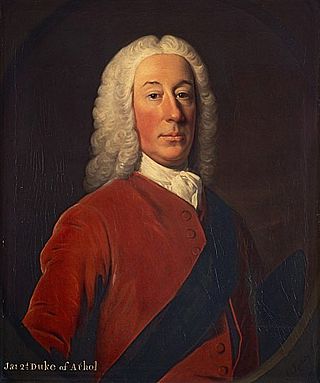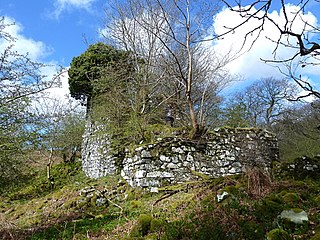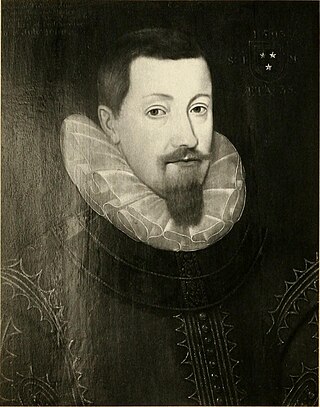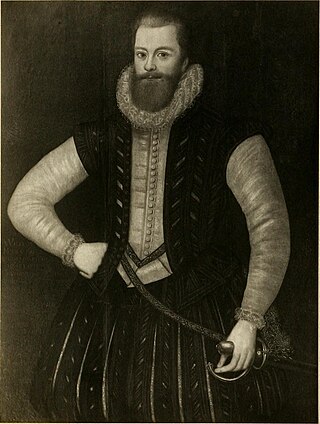Related Research Articles
John Stewart, 4th Earl of Atholl, called the Fair, was a Scottish nobleman and courtier. He was favoured by Mary, Queen of Scots, but later turned against her.

The Mormaer or Earl of Atholl was the title of the holder of a medieval comital lordship straddling the highland province of Atholl, now in northern Perthshire. Atholl is a special Mormaerdom, because a King of Atholl is reported from the Pictish period. The only other two Pictish kingdoms to be known from contemporary sources are Fortriu and Circinn. Indeed, the early 13th century document known to modern scholars as the de Situ Albanie repeats the claim that Atholl was an ancient Pictish kingdom. In the 11th century, the famous Crínán of Dunkeld may have performed the role of Mormaer.
The Raid of Ruthven, the kidnapping of King James VI of Scotland, was a political conspiracy in Scotland which took place on 23 August 1582. It was composed of several Presbyterian nobles, led by William Ruthven, 1st Earl of Gowrie, who abducted the king. The nobles intended to reform the government of Scotland and limit the influence of French and pro-Catholic policy, and to prevent or manage the return of Mary, Queen of Scots from England to rule with her son in an "association". Their short-lived rule of around 10 months is known as the "Ruthven" or "Gowrie Regime".

James Murray, 2nd Duke of Atholl,, styled Marquess of Tullibardine between 1715 and 1746, was a Scottish peer, and Lord Privy Seal.

Clan Murray is a Highland Scottish clan. The chief of the Clan Murray holds the title of Duke of Atholl. Their ancestors were the Morays of Bothwell who established the family in Scotland in the 12th century. In the 16th century, descendants of the Morays of Bothwell, the Murrays of Tullibardine, secured the chiefship of the clan and were created Earls of Tullibardine in 1606. The first Earl of Tullibardine married the heiress to the Stewart earldom of Atholl and Atholl therefore became a Murray earldom in 1626. The Murray Earl of Atholl was created Marquess of Atholl in 1676 and in 1703 it became a dukedom. The marquess of Tullibardine title has continued as a subsidiary title, being bestowed on elder sons of the chief until they succeed him as Duke of Atholl.
Lord Innermeath is an extinct title in the Peerage of Scotland created c. 1471 for Walter Stewart, 1st Lord Innermeath. Stewart had previously been Lord of Lorne, but resigned that title - which came with substantial comital power - under pressure from James III; James wished to weaken the remaining power of the Black Douglases, who had been allies of Walter's uncle, The Black Knight of Lorn. Walter had in fact held the Lordship of Lorne for only a few days, following the murder of his brother, the former Lord of Lorne.
Patrick Gray, 6th Lord Gray, known most of his life as Patrick, Master of Gray, was a Scottish nobleman and politician during the reigns of Mary, Queen of Scots and James VI of Scotland.

Alexander Stewart, 1st Earl of Galloway was a Scottish courtier and landowner.

John Murray, 1st Earl of Tullibardine was a Scottish courtier and leader of the Clan Murray.
Barbara Ruthven was a Scottish courtier and favourite of Anne of Denmark, expelled from court after the death of her brother.
John Stewart, 5th Earl of Atholl, (1563–1595) was a Scottish landowner.
John Grant of Freuchie was a Scottish landowner.
James Stewart, 1st Lord Doune (1529-1590) was a Scottish landowner.

William Murray, 2nd Earl of Tullibardine was a Scottish landowner and courtier.
William Murray of Tullibardine was a Scottish courtier and leader of the Clan Murray.
Margaret Fleming, Countess of Atholl (1536-1586) was a Scottish courtier and landowner rumoured to be involved in the occult. She served as lady-in-waiting to Mary, Queen of Scots.
James Stewart, 5th Lord Innermeath was a Scottish peer, courtier and landowner.
Sir John Wemyss was a Scottish landowner.
Marie Ruthven, Countess of Atholl, was a Scottish aristocrat.

Dorothea Stewart, Countess of Gowrie was a Scottish aristocrat. The dates of the birth and death of Dorothea Stewart are unknown.
References
- ↑ Calendar State Papers Scotland: 1589-1593, vol. 10 (Edinburgh, 1936), pp. 654, 657.
- ↑ Exchequer Rolls of Scotland , vol. 23 (Edinburgh, 1908), p. 141.
- ↑ M. S. Giuseppi, Calendar State Papers Scotland, vol. 12 (Edinburgh, 1952), p. 174.
- ↑ M. S. Giuseppi, Calendar State Papers Scotland, vol. 12 (Edinburgh, 1952), p. 32.
- ↑ HMC Laing Manuscripts at Edinburgh University, vol. 1 (Edinburgh, 1914), pp. 83-4.
- ↑ Register of the Privy Council, vol. 5 (Edinburgh, 1882), pp. 440-1.
- ↑ John, 7th Duke of Atholl, Chronicles of the Atholl and Tullibardine Families, vol. 1 (Edinburgh, 1908), p. 53-4.
- ↑ Register of the Privy Council, vol. 5 (Edinburgh, 1882), p. 448.
- ↑ Chronicle of Perth (Edinburgh, 1831), p. 7.
- ↑ John, 7th Duke of Atholl, Chronicles of the Atholl and Tullibardine Families, vol. 1 (Edinburgh, 1908), p. 52
- ↑ HMC Salisbury Hatfield, vol. 15 (London, 1930), 254.
- ↑ Melros Papers, vol. 1 (Edinburgh, 1837), pp. 8-10.